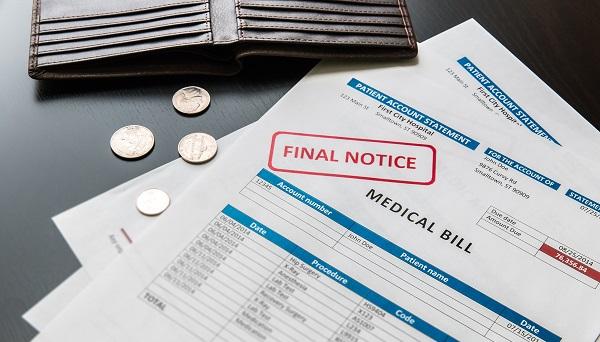High-Deductible Insurance May Deter ED Visits for Chest Pain
When employers switch from a low-deductible plan to higher out-of-pocket costs, people are less apt to go to the ED.

The observational study, published online in Circulation, found that patients living in high-poverty neighborhoods are most vulnerable to this financial burden. For them, the deductible change carries an increased risk of being hospitalized in the 30 days after their ED visit.
Lead author Shih-Chuan Chou, MD (Brigham and Women’s Hospital, Boston, MA), told TCTMD he was a bit surprised to see that insurance had an effect in this context, given the strong messages to seek medical attention for chest pain. Angina, he said, is especially worthy of attention because it’s so common.
Chou stressed it’s not possible to know what happened to the people who didn’t go to the ED—whether they saw their physician elsewhere, for example—but said the data support the idea that health deductibles influenced these decisions. Had insurance not mattered, hospitalization rates wouldn’t have differed among the patients who did present to the ED.
The study shows that “having high out-of-pocket costs can be potentially quite detrimental,” especially for people with low income, said Chou. Insurance companies should question whether money is actually being saved when some patients “defer care that could be beneficial,” he added.
Samuel Jones, MD (Chattanooga Heart Institute, TN), chair of the American College of Cardiology’s Health Affairs Committee, said that “it is important for clinicians to understand what is going on with our patients, because it is greatly impacting their care.”
These results indicate that patients may be delaying treatment for chest pain, Jones said, which could mean they present to the hospital with more-severe disease. COVID-19 drove home the point of “how disastrous that can be for many of our patients,” he told TCTMD, though many physicians may not realize insurance status can have such a strong impact.
When the delays occur in cardiovascular disease, they can be deadly. “It’s one thing if we’re just talking about a stuffy nose and an earache, but for cardiologists that’s not what we’re dealing with sometimes,” Jones commented.
Originally, higher deductibles were thought to give patients the freedom to choose a plan with lower premiums, Jones said. “Increasingly what we’re finding, though, is maybe patients didn’t really choose this. This is something that their employer chose for them, and that’s not the right thing for their particular situation. . . . That bothers me. It’s taking it out of the patient’s hands.”
The Specter of Out-of-Pocket Costs
Chou and colleagues used a commercial and Medicare Advantage claims database to identify adults ages 19 to 63 years whose employers had initially offered only an LDHP (≤ $500) but then made a mandatory switch to an HDHP (≥ $1,000) between 2003 and 2014. They matched 557,501 people who met these criteria with 5,861,990 controls whose employers continued to only offer low-deductible insurance.
Among these 6.4 million people, the mean age was 42 years, half were women, and approximately two-thirds were non-Hispanic white. Slightly more than a quarter lived in neighborhoods where at least 15% had not graduated high school, and 17% lived in places where at least 20% were below the federal poverty level.
When employers switched to HDHPs, visits to the ED for nonspecific chest pain decreased, as did the percentage of these visits that led to hospital admission.
Patients Switched From LDHP to HDHP
|
|
Relative Decrease |
Absolute Change per 10,000 Person-Years |
|
ED Visits for Nonspecific Chest Pain |
-4.3% |
-4.5 |
|
ED Visits for Nonspecific Chest Pain Resulting in Admission |
-11.3% |
-1.7 |
There were no differences in the likelihood of noninvasive testing or revascularization in the 30 days after the ED visit among patients switched to an HDHP, though there was a decrease in angiography (relative -8.2%; absolute -0.8 per 10,000 person-years). The 30-day rate of acute MI also wasn’t significantly affected.
Patients who lived in high-poverty areas were responsible for most of the reduction in ED visits and hospitalizations seen with the switch to HDHPs. And unlike in the overall group, these patients saw an uptick in acute MI hospitalization within 30 days of the ED visit (relative 29.4%; absolute 0.6 per 10,000 person-years).
The researchers say their “findings point to a growing need to incorporate cost-of-care information during shared decision-making between clinicians and patients, at a time when most employees have HDHPs.”
After doing all this research on high deductibles, I find it hard not to ask patients, ‘How much are you paying for this? Are you able to afford this?’ Shih-Chuan Chou
Neil M. Kalwani, MD, and Alexander T. Sandhu, MD (Stanford University, CA), writing in an editorial, note that this study doesn’t address the influence of insurance on patients “experiencing a truly emergent condition,” in that nonspecific chest pain by definition excludes those with ACS or other diagnoses. “Further study is needed to determine if patients covered by HDHPs are more likely to avoid or delay ED visits for chest pain caused by life-threatening diseases, such as ACS, leading to excess morbidity and mortality,” they write.
Still, they agree there are potential implications for health policy. At the moment, price transparency is hard to find in the clinical setting, Kalwani and Sandhu observe. “To determine cost-sharing for a patient covered by an HDHP, a clinician needs to know the patient’s health plan details, year-to-date healthcare spending, and the insurer’s negotiated rate for a given service. Realistically, the cost of care will only be available for patients and clinicians during a clinical encounter if there is real-time integration of health plan data with the electronic health record.”
How exactly to apply this information is still uncertain, they stress. “Even for trained clinicians, when a patient presents with a chief complaint of chest pain, it is often difficult to determine the clinical necessity and financial ramifications of recommending an emergent evaluation. We must therefore ask ourselves if it is reasonable to expect patients to make these decisions, especially when both their physical and financial health hang in the balance.”
For Chou, it’s important for clinicians to think about what financial stress their patients are facing. That said, “there’s an ethical question” about how this knowledge should or shouldn’t influence decision-making, he added.
“After doing all this research on high deductibles, I find it hard not to ask patients, ‘How much are you paying for this? Are you able to afford this? Is this going to make you forego [anything]? Are you going to work [more] because of that?’”
He continued: “I also feel pretty lost in the sense that I’m not sure that it’s a good thing for patients for us to ask. But at the same time, I’m struggling with [the knowledge that] this is the reality for the patients. So they’re going to ask that question, no matter whether or not I ask it.”
Only research can uncover how having price information at the point of care will affect outcomes, Chou observed. There’s the worry that patients less able to pay wouldn’t receive the same treatment once money enters the conversation.
Hospitals are becoming ever more conscious of costs, and patients also want transparency, Jones agreed. “Many of us clinicians feel it’s something that should be there. I get very frustrated on my patients’ behalf that when they ask, ‘What’s the cost of this going to be?’, and are trying to make decisions in a system that is so opaque.”
Exactly how it happens and when aren’t yet certain, but there will be a shift towards clarity, said Jones. “This maze of obfuscation by insurance companies, sometimes by the hospital systems themselves, really gets in the way of our patient-physician relationship and that’s not something we want to see.”
High-deductible plans may hold some benefits but shouldn’t be used as a blunt instrument, he stressed, adding that employers should think through what different plans mean for their employees.
Caitlin E. Cox is News Editor of TCTMD and Associate Director, Editorial Content at the Cardiovascular Research Foundation. She produces the…
Read Full BioSources
Chou S-C, Hong AS, Weiner SG, Wharam JF. Impact of high-deductible health plans on emergency department patients with nonspecific chest pain and their subsequent care. Circulation. 2021;Epub ahead of print.
Kalwani NM, Sandhu AT. High-deductible health plans and emergency care for chest pain: to go or not to go?]( https://www.ahajournals.org/doi/10.1161/CIRCULATIONAHA.121.055368 ) Circulation. 2021;Epub ahead of print.
Disclosures
- Chou, Kalwani, and Jones report no relevant conflicts of interest.
- Sandhu reports serving as a health policy consultant to Acumen.




Comments